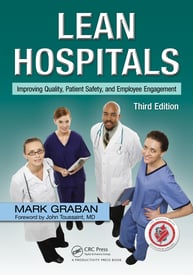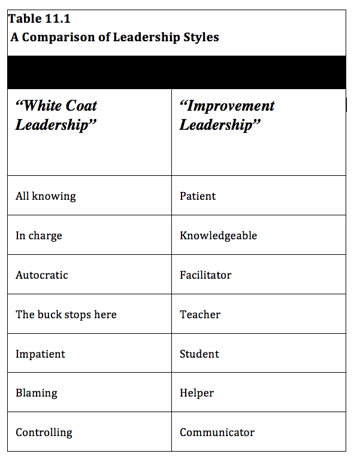Our Mark Graban has been with the KaiNexus team for five years now. In that time, he's released the 2nd edition (2011) and now the 3rd edition (June 2016) of his book Lean Hospitals: Improving Quality, Patient Safety, and Employee Engagement. Many of healthcare customers have used his book to introduce Lean to their organizations or to further their Lean efforts.
 Here is an excerpt from the start of Chapter 11, on leading and engaging employees:
Here is an excerpt from the start of Chapter 11, on leading and engaging employees:
Lean is not just about tools. It is also a distinct management method that guides what we do as managers and how we lead our employees. Former Toyota executive Gary Convis wrote:
“Management has no more critical role than motivating and engaging large numbers of people to work together toward a common goal. Defining and explaining what that goal is, sharing a path to achieving it, motivating people to take the journey with you, and assisting them by removing obstacles—these are management’s reason for being.”[i]
Is that true, today, for all leaders in your organization?
The Lean challenge goes beyond getting through an initial project. Once that phase is over, we still have people and processes to manage on an ongoing basis. That is why Lean is a never-ending journey—we have to guard against slipping back into old methods, and we have to push for additional improvement or, more accurately, create an environment where people want to continually improve. An engaged workforce, in which everybody is participating in identifying and implementing improvements, is the best way to achieve long-term success.
The traditional management mindset looks at a set of standard operating procedures and thinks, “We put a lot of thought into these processes, so they must be perfect.” Assuming otherwise might be considered a sign of failure or incompetence. Lean thinkers, on the other hand, assume that a process can always be improved, even if it seems to work fine today. The adage “If it’s not broke, don’t fix it” does not apply in a Lean setting. Lean leaders accept that they are not perfect. Not being perfect is acceptable as long as the team is continuously working toward perfection. Lean thinkers might say, “It’s not broke, but it’s not perfect, so let’s make it better!” Continuous improvement applies to everyone and everything, including the way we lead.
Before Lean, managers might not be aware of what is broken. With the best of intentions, employees might hide problems by working around them. It might look like people are busy, but they are busy dealing with waste. By learning to recognize waste, by getting out of our offices, and by encouraging people to speak up, we can finally start to see what is broken in the details of our processes. If employees are afraid to speak up, the burden falls on management to create an environment where people feel safe.
It is not enough to tell our employees they have to find and eliminate waste in their own work. We also have to commit to managing differently. Many supervisors and managers have difficulty making the transition to managing in the Lean workplace. Just as employees might fear layoffs, supervisors often fear losing their power or becoming irrelevant in a culture of employee engagement. Some managers (or executives) might have to be replaced, but most can be taught and coached in the Lean approach. David Mann said :
“What makes Lean difficult is not that it is so complicated but that it is so different from what we’ve learned.”[ii]
A few years into their Lean journey at ThedaCare, the hospital kept staff and leaders busy with "rapid improvement events" and other projects focused on the details of the work. One day, a "brave soul," as former CEO John Toussaint, MD describes them, asked a senior executive:
"How are we supposed to change when you are managing the same way?" [iii]
A question like that is a good sign that people are willing to speak up (and feel safe doing so).
In a culture of fear, a person would have to be very brave to question their leaders. In a Lean culture, leaders and staff can and do question and challenge each other in the name of improvement. Kim Barnas, former president of ThedaCare's two largest hospitals, wrote that a manager observed:
"The ultimate arrogance is to change the way people work without changing the way we manage them.”[iv]
 The question and comment served as a bit of a wake-up call for ThedaCare's leaders to create a management system and a new culture.
The question and comment served as a bit of a wake-up call for ThedaCare's leaders to create a management system and a new culture.
Traditionally, organizations tend to be very hierarchical and top down in their approach, many hospitals included. One hospital director said:
“We struggle with this. We still have a very command and control middle management workforce who are extremely protective of their departments and their problems.”
Managers in a Lean environment do not make all the decisions or solve all the problems. Lean managers avoid giving directives to their employees. Many managers do not know how to operate in any other way.
Toussaint humbly talked about his efforts to shift his own personal leadership style to set an example for the rest of the organization. The table shows his comparison of Lean leadership styles to what he calls traditional “white coat” leadership.[v]
The white coat, not limited to physicians, signifies formal position-based authority. The attributes of white coat leadership tend to stifle open communication and quality improvement.
"CEOs and other leaders are not generally rewarded for being humble," says Toussaint, adding, "No one person has all the answers, however, and humility demands that we recognize this… in humility there is great freedom. We can stop pretending to know everything."[vi]
Win a copy!
How has Lean changed your organization for the better? Leave a comment before Friday, July 1 with your story and we'll select one commenter to receive a free copy of the book, courtesy of Mark and KaiNexus.
Footnotes / References:
[i] Convis, Gary, “Role of Management in a Lean Manufacturing Environment,” Society of Automotive Engineers, http://www.sae.org/manufacturing/lean/column/leanjul01.htm (accessed March 26, 2015).
[ii] Vasilash, Gary S., “David Mann and Leading Lean,” Field Guide for Automotive Management, http://www.thefreelibrary.com/David+Mann+%26+leading+lean.-a0151922358 (accessed August 29, 2015).
[iii] Toussaint, John, and Roger Gerard, On the Mend: Revolutionizing Healthcare to Save Lives and Transform the Industry (Cambridge, MA: Lean Enterprise Institute, 2010), 81.
[iv] Barnas, Kim, "ThedaCare’s Business Performance System: Sustaining Continuous Daily Improvement Through Hospital Management in a Lean Environment,"The Joint Commission Journal on Quality and Patient Safety, September 2011, Volume 37, Number 9, Pages 387-399.
[v] Toussaint, John, presentation, Lean Healthcare Transformation Summit, June 9, 2010.
[vi] Toussaint, John, Management on the Mend, (Appleton: ThedaCare Center for Healthcare Value, 2015), 55.


Add a Comment